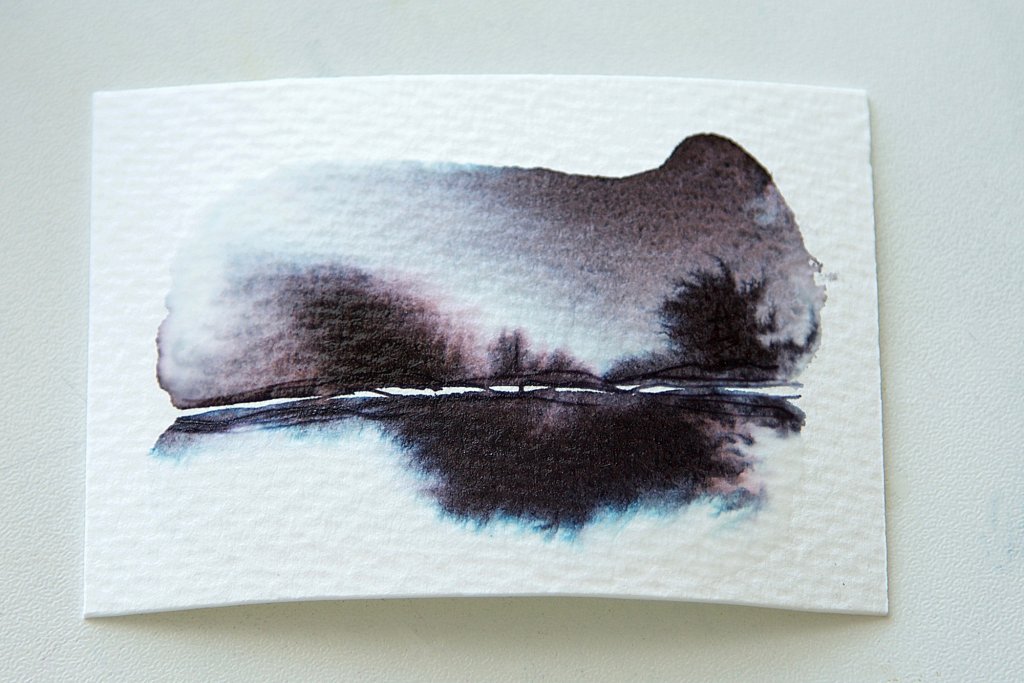My name is Nick Stewart, from Rochester, Kent, UK, and I create art using fountain pen ink. Chromatography is a big part part of my art process and explores the properties of fountain pen inks. By saturating an area of heavy rough textured watercolour paper, usually a Bockingford 200lb, and then adding a drop of ink into the wetted area, the ink blends with the water and reduces in concentration as it spreads away from the point of entry. As the ink comes out of solution the dyes that make up the ink can be observed in different areas as the paper dries. It’s taking chromatography into an art context.
By employing water-based techniques, one can achieve a convincing watercolour style painting by simply letting the inks do what they do. The demonstration below, has been created using one ink, Diamine Earl Grey. At first glance, one might assume that 3 or 4 colours have been employed.
The wonderful thing is that this simple wet in wet technique is actually easier and quicker than watercolour painting! Without even touching upon the word ‘serendipity’ I think this may appeal to all amateur artists for this one reason alone. The sky and foregrounds have created themselves!
What is also of interest is that all ink ranges are made differently. Each ink maker has their own recipes and processes. So, one range of inks may suit a particular subject matter better than another. Robert Oster Signature inks are ideal for bright conditions. KWZ inks are more suited to soft focus. Diamine are great for more graphic use. Noodler’s are more experimental and abstract but also check out: Vinta Inks, Troublemaker Inks and Sailor Ink Studio for more intense chromatic behaviours.
For enthusiasts of art journaling, diary keeping and sketching, this simple and natural process enables a simple and seamless visual continuity and a medium continuity between image and the written word. Why not give it a go?
Paper: Bockingford Watercolour Paper 200lb Rough
Equipment: 2 jars of water, Bottle of Diamine Earl Grey, Watercolour brush size 24, Watercolour brush size 5, Noodler’s Nib Creaper pen.
Instructions
Take swatch card measuring 70mm x 95mm and place lain landscape format and wet 3/5 of surface with large brush
With small brush add Diamine Earl Grey
Turn card upside down and wet surface 2-3mm below the wetted area above.
Dip pen into ink and draw line in through newly wetted area
Dip pen into ink and repeat step above
With pen, add a couple of ink marks to top area as this is now semi wet, the spread will be less and the ink more intense
Allow the chromatography to happen and enjoy watching the greys, purples, reds and turquoises slowly come out of the Earl Grey
Finished and dry landscape created with serendipity. Totally non contrived and utterly beautiful.
Works with most inks that display chromatic behaviours.
Please share your experiments on Instagram using: @quinkandbleach #fountainpeninkart #nickstewartinkart
Recommended8 recommendationsPublished in Tutorials
















How divine and dainty is that Nick. I totally love it. Funnily – I recently got into Welsh artisanal walnut ink by a lady called Catherine Lewis. He inks are so organic. I loved their chimerical quality as I loved yours above. Alison
Wow! That’s magical and very beautiful. For me, it’s a great opportunity to learn to loosen up as I tend toward too much control. Thanks for a great technique.
Thanks Sharon
Wow this is so cool. Thanks for sharing.
Thanks Chantel
Thanks so much for sharing this technique Nick! Stunning results. I love sketching with a fountain pen and have played with alcohol ink but have never tried this. I am going to be in a show for littles which can’t be larger than 5×7 inches and a few of these possibly are just what I have been searching for to supplement my little watercolors.
Go for it. Thanks for commenting. N
Nick, I’ve used fountain pen ink with a brush, but never quite like this. Your technique is incredible. I’ll have to get some Fountain Pen ink with chromatic properties so I can give this a try!
Please post your art! N
Thanks for sharing you video absolutely worth whiled can wait to try it!
Thanks Fatima
Having worked in plant biochemistry some time ago, I did science-based chromatography with homogenized plant components. More recently I started doing chromatography with ink on watercolor paper. If you make a round circle of water, or an asterisk shape with water, then let it dry until it’s semi-wet, it’s fun to drop ink right in the middle of the wet circle — a wet-on-wet technique. The ink moves outward, and can make interesting rainbow-like effects. And if you’re really inquisitive, put a drop of rubbing alcohol or a sprinkle of salt on the middle of the wet inked area. There’s a nice link between art and chemistry. Thanks for your lovely work.
I’m quite impressed with your technique and the effortlessly beautiful results!
Go for it. Thanks for commenting. N
Very cool! Thank you for sharing this…
This is very inspiring….I am so going to give this a go
Go for it. Thanks for commenting. N
Great technique with lovely results. Thanks for sharing it.
Wow I must try this with my color inks or liquid watercolor. This is so cool!
Go for it. Please post your art! Thanks for commenting. N
This is wonderful! I bet seeing it in action is mezmerizing. Thank you for sharing your work and story.
Would this work with ‘ordinary’ ink like, for example, Quink ink. I live in Turkey and getting specialist inks could be difficult. Your finished work is stunning and so unusual. Thank you!
They look amazing and very creative, I’ve never thought of doing this!
Have you done any more artwork using this technique?
Science and art together make me extremely happy. I’ll have to try this!
Wow..awesome technique!
Your work is absolutely beautiful! Thank you for sharing your step by step process!